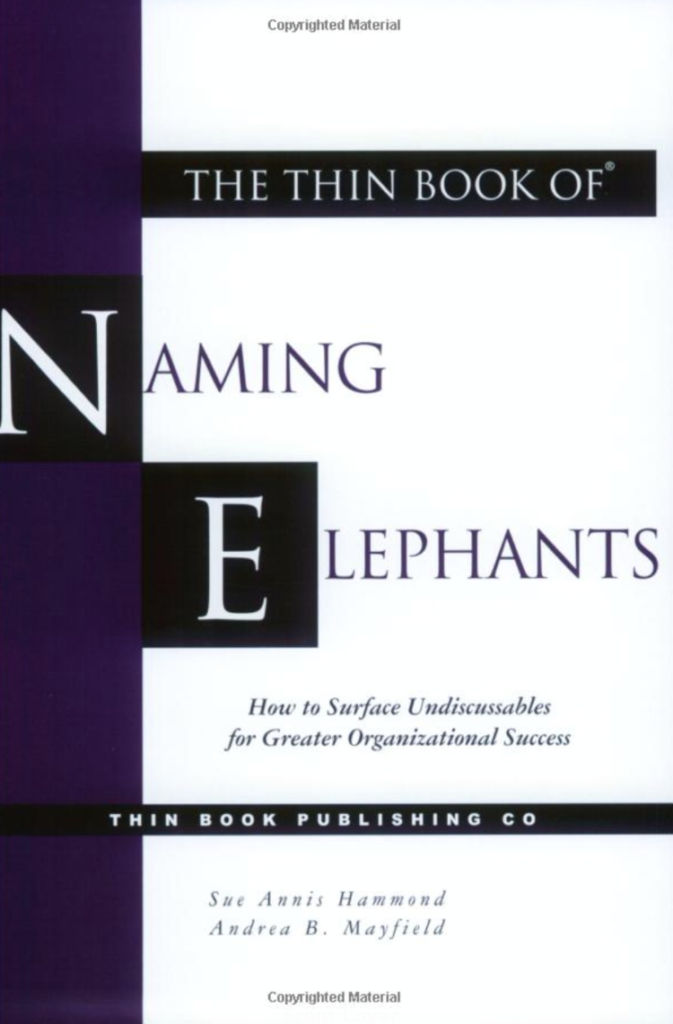BOOK FACTS
- Title: “The Thin Book of Naming Elephants”
- Author: Sue Annis Hammond, Andrea B. Mayfield
- Publisher: The Thin Book Publishing Company
- Copyright: 2004
- No. of Pages: 110
- No. of Chapters: 5
RATING (5 IS A MUST READ – 1 IS LOW INTEREST IN READING)
Readability: 4
Maintains Attention: 4
Applicability of Information: 4
REVIEW
The Thin Book of Naming Elephants focuses on “how to surface undiscussables for greater organizational success.” The unnamed elephant being those items that exist, but no one addresses so as not to cause surprise or concern. To bring clarity to this topic, NASA is given as an example. When the orbiter Columbia crashed, an investigation was performed that revealed that strategies were in place to prevent the crash and loss of life, but throughout the chain of command, no one was listening. There was no alignment between what was being said and what was actually taking place. Changing the circumstances, this is true in most organizations today.
Taking this concept a step further, the question is asked, “Why is this taking place?” It goes without saying that organizations are complex systems, and there is no absolute answer without delving into the layers of the organization. Some possibilities are cultural rigidity, fear of communication, caste systems, and indecisiveness.
Changing organizational culture is never an easy task, but by allowing people from all levels of the organizational hierarchy to have a voice, it can be done. The Thin Book of Naming Elephants dedicates the majority of its text to providing strategies to identify the source of the conflict, as well as identifying ways to be proactive in addressing this concern.
SUMMARY OF MAIN POINTS
- What organizations say and what they actually do may not be aligned. Regardless of the source, this “difference in realities” can cause chaos. Diverse assumptions of the situation and life come into play. In spite of this, it is possible to name the elephant.
- Paying attention to what people are saying and allowing others to speak may begin the healing process. Having leaders in place that understand and model the communication process is essential. Negativism and arrogance by leadership promote chaos.
- Naming elephants holds a risk factor. Valuing relationships, open discussion, and internal health-checks by organizations are not always the norm or acceptable. However, if the present method of doing business is not working, this can only be seen as an opportunity for change. The Thin Book of Naming Elephants uses the following quote by Paul Romer to exemplify this way of thinking, “A crisis is a terrible thing to waste.”
CALL TO ACTION
After reading this book, the following three points are a must-do to naming elephants:
- Identify what is undiscussable. If something isn’t working in the organization, gain an understanding of why it isn’t working. If you are not in the position to make decisions, then challenge them. Words of warning, before challenging them, seek to understand all aspects or assumptions of the situation.
- Surface the underlying assumptions people have about the elephant or situation. Start small and change the way of doing business. Build relationships by increasing personal contact rather than e-mail. Revise protocol for meetings, so that everyone has a voice. Be creative in getting to know others in the workplace.
- Learn to have constructive dialogue Effective communication is a skill. Work at gaining a better understanding of the organizational culture by seeking to understand how individuals view their world. You may be surprised as to what your perception is compared to others.


